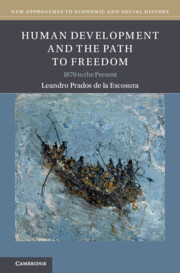Book contents
- Human Development and the Path to Freedom
- New Approaches to Economic and Social History
- Human Development and the Path to Freedom
- Copyright page
- Dedication
- Epigraph
- Contents
- Figures
- Tables
- Preface
- Introduction
- Part I An Aggregate View
- 1 Augmented Human Development: What Is It? How to Measure It?
- 2 Trends in Human Development
- 3 World Distribution of Human Development
- Part II The OECD and the Rest
- Postscript
- Book part
- Notes
- References
- Index
1 - Augmented Human Development: What Is It? How to Measure It?
from Part I - An Aggregate View
Published online by Cambridge University Press: 14 July 2022
- Human Development and the Path to Freedom
- New Approaches to Economic and Social History
- Human Development and the Path to Freedom
- Copyright page
- Dedication
- Epigraph
- Contents
- Figures
- Tables
- Preface
- Introduction
- Part I An Aggregate View
- 1 Augmented Human Development: What Is It? How to Measure It?
- 2 Trends in Human Development
- 3 World Distribution of Human Development
- Part II The OECD and the Rest
- Postscript
- Book part
- Notes
- References
- Index
Summary
Chapter 1 addresses the challenge of moving from an abstract concept, human development, to an empirical measure, the AHDI. The chapter discusses the measurement of human development, examining each of its dimensions: access to knowledge, a healthy life, and other aspects of well-being leading to a meaningful life, and exploring the reduced forms of these dimensions used as proxies. Then, it proposes a new, augmented human development index that combines achievements in terms of health and education, and material welfare in a context of freedom of choice and, therefore, satisfies the capabilities approach. In order to allow for its bounded nature and quality improvements, the new AHDI, unlike the HDI, derives the proxies for health and education, namely, life expectancy at birth and years of schooling, as Kakwani indices that transform them non-linearly, so increases at higher level represent higher achievements than similar increases at a lower level. Moreover, the AHDI adds a crucial dimension, civil and political liberties, to proxy agency and freedom. As in the HDI, the four indices are combined using unweighted geometric average to obtain the AHDI, as all of them are considered indispensable.
Keywords
- Type
- Chapter
- Information
- Human Development and the Path to Freedom1870 to the Present, pp. 13 - 36Publisher: Cambridge University PressPrint publication year: 2022

